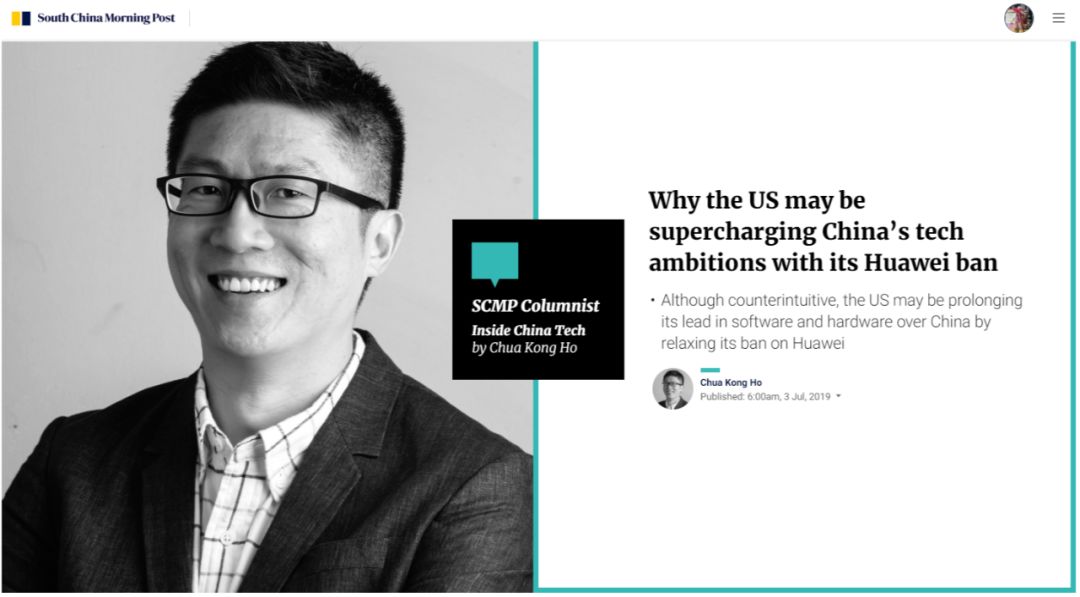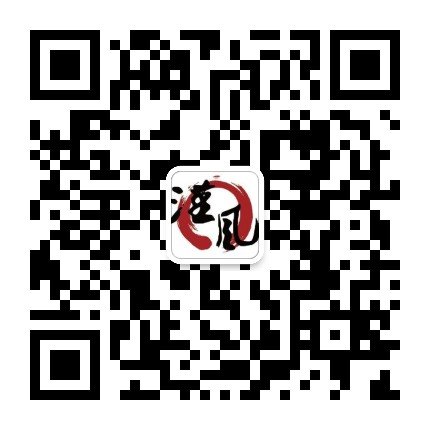
《南华早报》7月3日刊登科技编辑蔡康禾文章《为什么美国的华为禁令是在给中国科技快速充能》
文:Chua Kong Ho
译:范莉
今年五月中旬,美国商务部将华为及其70家关联企业列入实体清单,禁止美国公司未经许可与这家中国电信巨头进行商业往来。
从那时起,美国公司就争先恐后地想要弄清它们究竟要在多大限度上遵守法律禁令。从谷歌、微软到高通、英特尔,这一连串美国供应商暴露出华为乃至中国对美国技术的依赖性。
所以当美国总统特朗普于上周末在日本大阪的G20峰会表示他将放松对华为的禁令时,可想而知华为深圳总部里的人们都松了一口气。不过,美国公司也同样在祈求好运,盼望善变的特朗普这次会言而有信。
这是因为对美国技术公司而言,放宽针对华为的贸易禁令除了能恢复美企重要的收入来源,还可能会使华为不再有足够的动力为旗下手机、平板电脑等设备推出其具有专利的鸿蒙操作系统,并减缓自主研发半导体零部件的步伐,
这样说可能有违人们的直觉,但美国可能得放松禁令,而不是全力出击试图打垮潜在的挑战者,才能延续它在软硬件领域相对中国的领先优势。
中国有句老话说得好,兔子急了也咬人,何况华为不是兔子。
华为去年营收突破1000亿美元,与谷歌母公司Alphabet这样的全球化公司同处一个量级。即便遭受美国制裁的打击,华为创始人任正非仍然表示预计今年与明年的营收将大体保持同等水平。
去年,华为在研发上投入了153亿美元,仅次于亚马逊、Alphabet和三星电子。其业务涵盖了移动设备、云计算和智能城市管理等多个领域。华为通信网络设备的市场份额冠居全球,它们对铺设超高速5G网络发挥着不可或缺的作用,而5G网络则将为自动驾驶汽车、虚拟现实以及智能城市等一切的一切提供动力。
在新加坡上周举办的“InnovfestUnbound”创新科技展上,作为主要赞助商之一,华为全天在自家展区展示各种技术。我路过时发现那里被挤得水泄不通,大家都在听华为演示员详细讲解其计算机视觉的准确度有多么高。
美国5月中旬颁布的贸易禁令使华为感受到了生存压力,因而准备加速推出自研操作系统。据《南华早报》报道,早在2012年美国司法部开始对华为展开调查时,华为就开始研发自己的操作系统了。目前华为之所以迟迟没有推出这款操作系统,是因为与之配套的应用程序生态系统还不成熟,以及它与市场主流的安卓系统还不完全兼容。
这是一个典型的先有鸡还是先有蛋的问题,开发者不会为一个没有市场的操作系统开发应用,同时华为也不会在没有软件生态系统的情况下推出操作系统。但在美国颁布禁令后,情况发生了变化,华为手机掌门人余承东表示,新的操作系统可能明年就会推出。
谷歌和微软非常清楚华为操作系统背后的重大利害关系,哪怕它一开始再不成熟、不完整。华为内部人士表示,这两家美国公司一直在积极帮助华为应对美国政府,因为它们无法承受失去华为的后果,而且一旦消费者转而使用华为的操作系统,其他中国智能手机公司也会跟进,这个后果是谷歌和微软更加不愿看到的。
值得注意的是,拥有独立的操作系统和生态系统的美国智能手机制造商,只有苹果公司一家。
有报道称,美国芯片公司英特尔、高通和赛灵思也在游说美国政府,争取解除针对华为的禁令,因为一旦失去华为这个大客户,它们的收入将减少数十亿美元。
所以具有讽刺意味的是,美国若想在技术上维持优势地位,最好的做法是确保不向华为和中国技术生态系统“断供”,让它们出于商业考虑找不到理由去生产较为落后的替代品。
在这种情况下,只要中国企业继续依赖美国技术,就无法完全实现自给自足,这样一来美国技术便得以维持其全球领先地位。
不过,单凭这种商业考虑恐怕已不足以让技术界回到禁令前的状态。中国的主流观点认为,美国之所以打压华为是因为它意识到了美国企业已无法在5G领域和华为正面竞争。
如果中国企业不再确信未来一定能获取美国技术来支持它们的手机、笔记本电脑、数据中心和超级计算机,它们会怎么做呢?答案很简单,它们会向自主研发投入更多资源,尽管单纯从经济角度来看这并不合算。
这就是为什么中国国家主席习近平去年五月要呼吁中国科技自力更生、自主创新,当时美国也用同样的技术断供手段来对付中国第二大通信设备制造商中兴。对中国而言,庞大的国内市场是个有利因素,它能对本土自研技术产生足够的需求。
截至目前,美国不是一次,而是两次卡住了中国的脖子,如今尽管它表示愿意松松手,但仍然很难想象中国企业会甘心继续听凭美国摆布。
Why the US may be supercharging China’s tech ambitions with its Huawei ban
The US Commerce Department placed Huawei and 70 of its affiliates on a blacklist in mid-May, a move that banned US companies from doing business with the Chinese telecoms gear giant without permission.
Since then, American companies have scrambled to figure out the legal boundaries of their compliance. From Google and Microsoft to Qualcomm and Intel, the line-up of US suppliers laid bare the reliance that Huawei, and by extension, China, has on American technology.
So when President Donald Trump said over the weekend at the G20 meeting in Osaka, Japan, that he was relaxing the ban on Huawei, one can imagine the collective sigh of relief at the Chinese company’s Shenzhen headquarters. But American companies too will be keeping their fingers crossed that the mercurial US leader will deliver.
That is because beyond the resumption of an important source of revenue for American tech companies, a relaxation of the trade ban may remove the impetus for Huawei to roll out a proprietary backup operating system for its phones, tablets and other devices, and blunt the pace of developing its own semiconductors.
Although counterintuitive, the US may be prolonging its lead in software and hardware over China by relaxing the ban as opposed to going all out to try and crush would-be challengers.
But as a Chinese saying goes, even a rabbit will bite when cornered, and Huawei is no rabbit.
Huawei crossed US$100 billion in annual revenue last year, putting it in the league of global companies like Google’s parent, Alphabet. Even after taking a hit from US sanctions, Huawei founder Ren Zhengfei said he expects the company to maintain about the same level of revenue this year and next.
Huawei spent US$15.3 billion on research and development last year, trailing only Amazon, Alphabet and Samsung Electronics. The company is in everything from mobile to cloud computing to smart city management. It is the global market share leader in telecommunications network equipment that is critical for the roll-out of ultra-fast 5G networks, which when fully implemented promises to power everything from autonomous cars to virtual reality to smart cities.
At last week’s Innovfest Unbound tech conference in Singapore, Huawei was one of the major sponsors and held presentations throughout the day at its stand showcasing its various technologies. When I passed by, the place was jam-packed with people listening to a Huawei presenter detailing the accuracy of its computer vision abilities.
The US trade ban in mid-May has forced Huawei into overdrive to ensure its survival. As the Post reported, Huawei first started working on its own OS back in 2012 when the US Justice Department began investigations into the company. What is holding the company back has been the lack of an ecosystem of apps as well as its compatibility with Android, the dominant OS in the market today.
In a classic chicken-and-egg situation, developers have little incentive to build apps for an OS that is not on the market, while Huawei has little reason to introduce the OS without the accompanying ecosystem. But that has changed with the US ban, and Huawei’s mobile chief, Richard Yu Chengdong, was quoted as saying the new OS could be ready in the coming year.
Google and Microsoft understand what is at stake with a Huawei OS, no matter how immature or incomplete it is at the start. Huawei insiders have said that the two American companies have been active in helping the company deal with the US government, because they cannot afford to lose Huawei, and perhaps more importantly, potentially other Chinese smartphone companies as customers should they switch to a Huawei OS.
It is important to note that the only major US smartphone maker, Apple, has its own separate OS and ecosystem.
Reports suggest that US chip firms Intel, Qualcomm and Xilinx have also been lobbying against the Huawei ban, as they stand to lose billions in revenue from losing the Chinese giant as a customer.
Ironically, the best course of action to ensure US superiority in tech may be to supply Huawei and China’s tech ecosystem so as to remove the economic argument for producing inferior alternatives.
In this scenario, Chinese companies would have no chance for full self-sufficiency as long as they remain reliant on US tech, thus preserving America’s global lead.
But whether the economic argument alone is enough to return the tech world to the pre-ban status quo is debatable. A prevalent view in China is that the US is suppressing Huawei because it realised it has no champion able to take it on in 5G.
But what if Chinese companies no longer believe they can have reliable access to American technology to run their phones, laptops and data centres, or supercomputers? The simple answer is to pour in even more resources into building their own, even if economically it does not make sense.
That may be reflected in President Xi Jinping’s call last May for China to go all-in for scientific self-reliance when the same US strategy of withholding tech from ZTE crippled China’s No. 2 telecoms gear manufacturer. In China’s favour is a large domestic market that can generate demand for home-grown tech.
It is hard to imagine that having been held in a chokehold not once, but twice, that China Inc. would be happy just because the US says it will loosen its grip.
(End)


